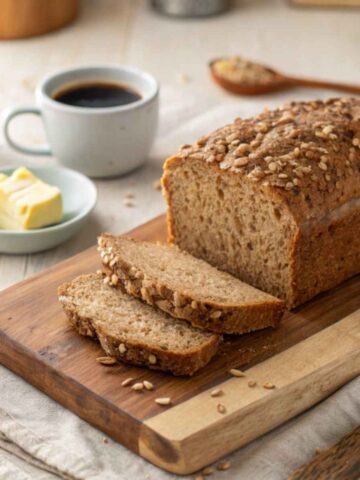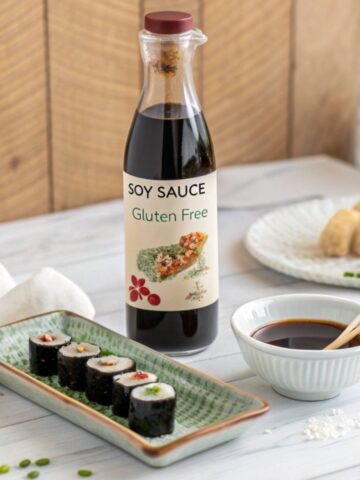Grits are a beloved staple in Southern cuisine, known for their creamy texture and versatility in sweet and savory dishes. However, for people on a gluten-free diet, questions often arise about whether this popular food is safe to eat. Are grits gluten free? This article will explore what grits are made from, their nutritional benefits, and how to enjoy them safely on a gluten-free diet.

Jump to:
- Understanding Gluten and Its Role
- Are Grits Naturally Gluten-Free?
- Types of Grits and Their Nutritional Profiles
- Risks of Gluten Cross-Contamination in Grits
- How to Identify Gluten-Free Grits
- Popular Gluten-Free Grits Brands
- Cooking Gluten-Free Grits at Home
- Grits in Gluten-Free Breakfast Dishes
- Nutritional Benefits of Grits
- Grits vs. Polenta: Are They Gluten-Free?
- How to Prevent Cross-Contamination at Home
- GF Grits Recipes for Special Diets
- Grits and Gluten-Free Baking: A Surprising Ingredient
- Conclusion
- FAQs
- Gluten-Free Grits
Understanding Gluten and Its Role
What Is Gluten?
Gluten is a protein in grains like wheat, barley, and rye. It’s responsible for the elasticity of dough and provides structure to baked goods. While gluten is harmless to most people, it can cause serious health issues for individuals with celiac disease or gluten sensitivity.
Gluten-Related Disorders: Celiac Disease and Gluten Sensitivity
For those with celiac disease, consuming gluten triggers an immune response that damages the lining of the small intestine, leading to a range of symptoms, from digestive issues to nutrient deficiencies. People with non-celiac gluten sensitivity may experience similar symptoms without the intestinal damage.
Are Grits Naturally Gluten-Free?
Corn as the Main Ingredient in Grits
Chefs typically make grits from corn, which is naturally gf. Therefore, they serve as a great option for those who follow a gluten-free diet. Corn is not one of the gluten-containing grains, meaning plain grits should be safe for those avoiding gluten.
Why Grits Are Considered Gluten-Free
Grits are not inherently gf because they are made from ground corn. However, certain factors can introduce gluten into grits during processing, packaging, or when flavored with gluten-containing additives. It's important to check labels and opt for certified gluten-free products.
Types of Grits and Their Nutritional Profiles
Several types of grits are available, and while they all come from corn, the processing method can impact their nutritional content and texture.
Stone-Ground Grits
Stone-ground grits are the least processed type, retaining more of the corn kernel’s nutrients. They have a coarser texture and take longer to cook but offer a richer flavor.
Quick Grits
Quick grits are more finely ground than stone-ground grits and are partially pre-cooked, which reduces cooking time. While convenient, they may lack some texture and flavor in stone-ground varieties.
Instant Grits
Instant grits are fully pre-cooked and dried, requiring only boiling water to prepare. However, instant varieties may contain additives or preservatives, so checking for gluten-free certification is essential.
Hominy Grits
To make hominy grits, manufacturers treat corn with alkali to remove the hull. As a result, this process gives the grits a slightly different flavor and texture compared to regular grits.
Risks of Gluten Cross-Contamination in Grits
While grits are naturally gf, cross-contamination can occur if processed in facilities that handle gluten-containing grains like wheat or barley.
How Cross-Contamination Occurs in Processing
Cross-contamination occurs when processors use the same equipment for gluten-containing products and gluten-free items. As a result, trace amounts of gluten may be transferred. This is particularly risky for people with celiac disease who need to avoid even small amounts of gluten.
Choosing Certified Gluten-Free Grits
To ensure your grits are safe, look for certified gf products. This certification indicates that the product has undergone rigorous testing and meets strict gluten-free standards. Consequently, it minimizes the risk of cross-contamination.
How to Identify Gluten-Free Grits
When shopping for grits, knowing how to identify gf varieties is essential.
Reading Labels for Gluten-Free Grits
Always read the label carefully to check for any hidden gluten-containing ingredients. Look for phrases like “contains wheat” or “may contain traces of gluten,” which indicate potential cross-contamination.
Gluten-Free Certification: What to Look For
A gluten-free certification label guarantees that experts have tested the product for gluten content and confirmed it contains less than 20 parts per million (ppm) of gluten. Consequently, this level is deemed safe for individuals with celiac disease. Brands like Bob’s Red Mill and Arrowhead Mills offer certified gf grits.
Popular Gluten-Free Grits Brands
Several brands offer gf grits that are safe for those with celiac disease or gluten sensitivity. Here are some top choices:
1 Bob’s Red Mill Gluten-Free Corn Grits
Bob’s Red Mill is known for its wide range of gf products, including their gluten-free corn grits. These are stone-ground for a hearty texture and rich flavor.
2 Palmetto Farms Stone-Ground Grits
Palmetto Farms offers stone-ground grits that are naturally gf. They have a coarse texture and are perfect for traditional Southern dishes.
3 Arrowhead Mills Organic Yellow Corn Grits
For those seeking an organic option, Arrowhead Mills produces yellow corn grits that are gluten-free and certified organic.
Cooking Gluten-Free Grits at Home
Grits are incredibly versatile and can be cooked in various ways. Here’s a basic recipe for creamy, gf grits:
Basic Recipe for Creamy Gluten-Free Grits
Ingredients:
- 1 cup gf corn grits
- 4 cups water or broth
- 1/2 teaspoon salt
- Two tablespoons butter (or dairy-free alternative)
Instructions:
- Bring the water or broth to a boil in a medium saucepan.
- Slowly whisk in the grits and salt, reducing the heat to low.
- Simmer for 20-25 minutes, stirring occasionally, until the grits are thick and creamy.
- Stir in butter and season to taste with salt and pepper.
Tips for Flavoring Grits: Savory and Sweet Options
For savory grits, try adding cheese, garlic, or herbs. If you prefer sweet grits, stir in honey, maple syrup, or fruit for a delicious breakfast.
Grits in Gluten-Free Breakfast Dishes
This versatile dish can be transformed into hearty gluten-free breakfasts. From simple, creamy grits to savory combinations, they can be the foundation for many delicious meals.
Gluten-Free Shrimp and Grits
One of the most famous Southern dishes, shrimp and grits, is naturally gf when made with gluten-free ingredients—simply top creamy grits with sautéed shrimp, garlic, and herbs for a classic, comforting dish.
Ingredients:
- 1 cup gf grits
- 4 cups water or broth
- 1/2 teaspoon salt
- 1 pound shrimp, peeled and deveined
- Two tablespoons butter (or dairy-free alternative)
- Garlic, parsley, and spices for seasoning
Gluten-Free Cheesy Grits
Cheesy grits are a fantastic gluten-free breakfast or side dish. Adding sharp cheddar or Parmesan to creamy grits elevates their flavor and adds a rich, comforting texture.
Ingredients:
- 1 cup gf grits
- 4 cups water
- 1/2 teaspoon salt
- 1 cup shredded sharp cheddar cheese
- Two tablespoons butter (or dairy-free alternative)
Nutritional Benefits of Grits
Grits are a healthy, naturally gf option that fits well into various diets. Here’s a look at their nutritional profile:
Low-calorie, High-Carb Fuel
Grits are relatively low in calories while providing a good source of complex carbohydrates, which can fuel your day. A standard serving of grits contains around 150 calories and is an excellent option for those seeking an energy-boosting breakfast.
Fiber Content and Digestive Health
Stone-ground grits, in particular, retain more fiber than more processed varieties. Fiber is essential for digestion and helps maintain a healthy digestive system, making grits a good choice for promoting gut health.
Grits vs. Polenta: Are They Gluten-Free?
People often confuse grits and polenta, which are made from ground corn. While they share similarities, they differ in texture, preparation, and flavor.
What’s the Difference Between Grits and Polenta?
Cooks make polenta, an Italian dish, from coarsely ground yellow corn. In contrast, they prepare grits with white corn, which can be ground either coarsely or finely. Both dishes are naturally gluten-free; however, they differ in texture and cooking time. Specifically, polenta often has a thicker consistency, while grits tend to be creamier.
Gluten-Free Considerations for Both
Both grits and polenta are naturally gf, but cross-contamination can occur during processing. Always look for gluten-free certifications when purchasing polenta or grits, especially if you have celiac disease or severe gluten sensitivity.
How to Prevent Cross-Contamination at Home
When preparing grits at home, it’s crucial to prevent cross-contamination, mainly if your kitchen includes gluten-containing products.
Safe Storage Practices for Gluten-Free Grits
Store your gf grits in airtight containers to avoid contamination from gluten-containing products in your pantry. If possible, keep them in a designated gluten-free section of your kitchen.
Using Separate Cookware and Utensils
To avoid cross-contamination, use separate cookware, utensils, and serving tools for gluten-free meals. Even small traces of gluten from shared pans or spatulas can pose a risk for individuals with celiac disease.
GF Grits Recipes for Special Diets
Grits are versatile and can be easily adapted to fit into various dietary restrictions, from vegan to dairy-free.
Vegan gf Grits
To make vegan grits, replace dairy-based ingredients like butter or cheese with plant-based alternatives. Coconut milk, olive oil, or vegan cheese can add creaminess while keeping them plant-based and gluten-free.
Dairy-Free and Gluten-Free Grits
For those avoiding dairy and gluten, swap out butter or cheese for dairy-free alternatives like coconut oil, almond milk, or nutritional yeast for a cheesy flavor without the dairy.
Grits and Gluten-Free Baking: A Surprising Ingredient
Grits are versatile and can elevate your gf baking by adding unique texture and flavor to a variety of dishes, not just at breakfast or dinner.
Using Grits in Gluten-Free Bread and Muffins
Incorporating finely ground grits into your gf baking can add a unique, slightly crunchy texture to breads, muffins, or pancakes. They pair well with cornmeal and enhance the flavor of cornbread or savory muffins.
How Grits Can Add Texture to Gluten-Free Dishes
You can use grits as a binding agent in gf casseroles or as a topping for baked dishes like gf mac and cheese. Additionally, they add a crunchy, golden crust without any gluten.
Conclusion
You can enjoy grits as a versatile and naturally gluten-free food in various dishes, from breakfast to dinner. Whether you prefer stone-ground, quick, or instant grits, they can easily fit into your gf diet with proper precautions to avoid cross-contamination. As more gf brands emerge, it's easier than ever to enjoy the creamy, comforting goodness of grits while staying gluten-free.
So, if you’re following a gf lifestyle and haven’t tried grits, now’s the perfect time to incorporate them into your meals. From classic Southern dishes to creative new recipes, grits offer endless possibilities for a delicious, gf dining experience.
FAQs
Due to the risk of cross-contamination during processing, not all manufacturers guarantee that their grits are gf. Look for certified gf grits to ensure they are safe to consume.
Choose grits that are labeled gf and processed in a gluten-free facility to avoid cross-contamination. Be cautious of bulk bins or products processed on shared equipment.
Yes, grits are naturally gf when made from corn. However, always check the label to confirm there’s no gluten contamination.
Some manufacturers may add additives to instant grits or process them in facilities that handle gluten-containing grains. Always check the packaging for gluten-free certification.
Some popular gluten-free grit brands include Bob’s Red Mill, Arrowhead Mills, and Palmetto Farms. Look for these trusted brands when shopping for gf grits.

Gluten-Free Grits
- Total Time: 30 minutes
- Yield: 4 Servings 1x
Description
Thisbasic gluten-free grits recipe is creamy, flavorful, and perfect for breakfastor as a side dish. Made from naturally gluten-free corn, these grits are simpleto prepare and can be customized with sweet or savory
Ingredients
- 1 cup gluten-free corn grits
- 4 cups water or broth
- 1/2 teaspoon salt
- Two tablespoons butter (or dairy-free alternative)
- Salt and pepper to taste
Instructions
- Bring water or broth to a boil in a medium saucepan.
- Slowly whisk in the grits and salt, reducing heat to low.
- Simmer for 20-25 minutes, stirring occasionally, until the grits are thick and creamy.
- Stir in butter, adjust seasoning with salt and pepper, and serve warm.
- Customize with cheese, herbs, or your favorite gluten-free toppings.
Notes
For vegan or dairy-free grits, use plant-based butter or coconut oil. You can also add almond milk for extra creaminess without dairy.
- Prep Time: 5 minutes
- Cook Time: 25 minutes
- Category: Breakfast, Side Dish
- Cuisine: American
Nutrition
- Calories: 150
Keywords: Gluten-Free Breakfast, gluten-free grits, Southern cuisine





Leave a Reply